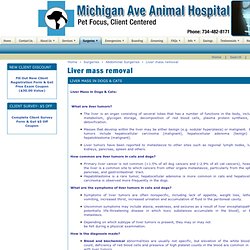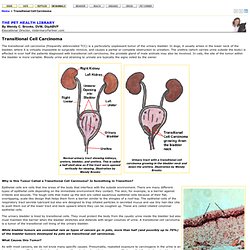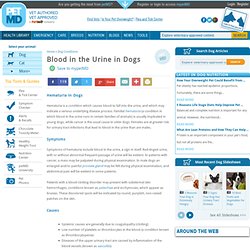

Liver Tumors. After surgery, your pet is monitored in an intensive care unit and medication is administered to control pain.

Fluids and antibiotics may be administered via an intravenous catheter for a few days after the procedure to maintain hydration and prevent infection. Daily blood tests may be performed to check for signs of internal organ dysfunction and internal bleeding. If needed, a blood or plasma transfusion may be given. At home, pain medications and antibiotics may be required. If your pet does not eat a regular diet, a low fat home-cooked diet may be offered. Liver Tumors Metastatic and Miscellaneous. These notes are provided to help you understand the diagnosis or possible diagnosis of cancer in your pet.

For general information on cancer in pets ask for our handout "What is Cancer". Your veterinarian may suggest certain tests to help confirm or eliminate diagnosis, and to help assess treatment options and likely outcomes. Because individual situations and responses vary, and because cancers often behave unpredictably, science can only give us a guide. Liver Disease in Dogs & Cats. Liver Mass in Dogs & Cats: What are liver tumors?

The liver is an organ consisting of several lobes that has a number of functions in the body, including metabolism, glycogen storage, decomposition of red blood cells, plasma protein synthesis, and detoxification.Masses that develop within the liver may be either benign (e.g. nodular hyperplasia) or malignant. Liver tumors include hepatocellular carcinoma (malignant), hepatocellular adenoma (benign) and hepatoblastoma (malignant).
Liver tumors have been reported to metastasize to other sites such as regional lymph nodes, lungs, kidneys, pancreas, spleen and others. Bladder Cancer in Dogs - A top guide to the signs and symptoms of this condition. Tumors and bladder cancer in dogs is actually fairly rare but if your dog does experience this type of cancer then symptoms can include blood in the urine, cystitis, difficulty when attempting to urinate, breathing problems, abdominal pain, vomiting, poor appetite, coughing and a reluctance to go for a walk or exercise.

Liver Cancer in Dogs, Signs of Liver Problems, Prevention. Liver cancer in dogs is actually fairly rare with the condition affecting less that 1 1/2 percent of dogs.

However, having said this it is more common for the disease to metastasize in the liver (basically meaning that it started somewhere else possibly in the spleen, pancreas or gastrointestinal tract and then spreading to the liver). Transitional Cell Carcinoma. The transitional cell carcinoma (frequently abbreviated TCC) is a particularly unpleasant tumor of the urinary bladder.

In dogs, it usually arises in the lower neck of the bladder, where it is virtually impossible to surgically remove, and causes a partial or complete obstruction to urination. The urethra (which carries urine outside the body) is affected in over half the patients diagnosed with transitional cell carcinoma; the prostate gland of male animals may also be involved. In cats, the site of the tumor within the bladder is more variable. CanineUrinaryBladderCancer. The National Canine Cancer Foundation - Urinary Bladder Cancer. Description- Urinary bladder cancer accounts for approximately 2% of all reported malignancies in dogs.

With more than 60 million dogs in the USA, deaths from urinary bladder cancer are increasing rapidly. There are various types of bladder tumors like squamous cell carcinoma (arise in the epithelial cells), adenocarcinoma (arise in the glandular epithelium), undifferentiated carcinoma, rhabdomyosarcoma (tumor of the striated muscle- form of fibers combined into parallel fibers like the skeletal and the cardiac muscles), fibroma (tumors made of fibrous or connective tissue. They can grow in any part of the organ that arise from mesenchyme tissues) and other mesenchymal tumors (lesions that arise from soft tissues) that occur less frequently. But invasive transitional cell carcinoma or TCC is the most common type of canine urinary bladder cancer. Most TCCs vary between intermediate to high grade papillary proliferative lesions. Clinical Staging System by World Health Organization (WHO) Blood in the Urine in Dogs.
Hematuria is a condition which causes blood to fall into the urine, and which may indicate a serious underlying disease process.

Bladder Stones (Urinary Calculi) in Dogs. Although we often call them "bladder stones" in dogs, they are also known as urinary calculi and the condition is referred to as urolithiasis.

Stones may actually form anywhere in the entire urinary tract. The urinary stones in dogs can be found in the kidneys, ureters (tiny tubes that carry urine from the kidneys to the bladder), bladder, or urethra (the tube from the bladder to the outside of the animal). However, in the dog, over 85% of stones are found within the bladder itself. Malassezia Dermatitis: Is it Complicating your Life?
Malassezia (yeast) dermatitis can result in a primary skin problem or be present secondary to underlying disease.

Because its presence can mimic (and complicate) other diseases such as atopy and food allergy, it is important to know how to recognize the organism, and of course, treat for it. Malassezia pachydermatis (Pityrosporum) is a lipid-loving, normal inhabitant of canine and feline skin residing in the ear canals, rectum/anal sacs and vagina. It was first described as a disease in humans (seborrheic dermatitis) in 1847 by Malassez. The commensal yeast organism becomes a problem due to excessive sebum production (Malassezia loves lipids), heat, humidity, bacteria or inflammation. Underlying allergy or endocrine disease i.e. hypothyroidism can predispose to yeast infection. Malassezia in Dogs Signs and Treatment by Alison Bowler. Alison Bowler's image for: "Malassezia in Dogs Signs and Treatment" Caption: Location: Image by: Malassezia dermatitis is a fungal disease affecting the skin.
In dogs, the yeast causing the condition is Malassezia pachydermatis. Conditions that may give rise to a dog developing Malassezia include allergies, chronic skin disease, Staphylococcus intermedius skin infection and treatment with antibiotics or corticosteroids. Certain breeds are particularly prone to developing this infection. A dog with malassezia may exhibit a number of different signs. Some dogs have only a local infection affecting only one part of the body. A qualified veterinarian can provide a diagnosis of cases of this type of dermatitis and should be consulted to ensure successful treatment. The condition requires several weeks of treatment. Many cases respond to an antifungal shampoo combined with a skin degreaser provides a topical treatment. Reference sources: Provet Healthcare information Pet education.com.